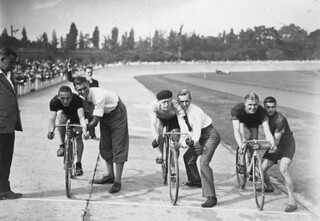A Tale of Two Velodromes
Paul Taylor
London’s two velodromes were built in the 19th and 21st centuries. The indoor track at the Lee Valley Velodrome, one of the fastest in the world, is housed in a beautiful stadium built at cost of £94 million. Its distinctive roof, a hyperbolic paraboloid clad in 5000m2 of custom-cut Western red cedar, is a prominent landmark at the edge of the 2012 Olympic park. The open-air track at Herne Hill is completely hidden in a South London suburb. The entrance lies at the end of a narrow path between two semi-detached houses. Coming out behind them, you see a wall supporting a low bank of rusting metal seats. This little stand is the only permanent structure that was built – at any of the venues – for the 1948 Olympics. The pavilion, also derelict, dates from 1891, when the track opened. In 2015, any spectators sit on folding plastic seats in a small area of open terracing in front of the older stands. There is no café. Competitors change in a portaloo in a cluster of temporary cabins and containers behind the old pavilion.
It is a space wonderfully cut off from the world around it, like a secret garden in a children’s story. In the 1890s, thousands of spectators would have crammed in to watch celebrities like Arthur Linton win a 24-hour race or set the record for 100 miles. The track centre, originally a rugby pitch, hosted Crystal Palace’s home games during the First World War and an anti-aircraft battery during the Second. In 1948, an unknown Mario Ghella pipped the world champion and local favourite, Reg Harris, to Olympic gold. In the 1950s, 12,000 people came to watch Fausto Coppi compete in exhibition races – held on Sundays when London’s Italian cafes and restaurants would be shut. Tommy Simpson launched his career here. I’m told, though I haven’t seen it, that there’s a photo of him riding on the advertising hoardings.
Bradley Wiggins describes himself as a son of Herne Hill – he began competing in the Monday night track league at the age of 12 – and says that when he goes back he still recognises people who saw his father race in Good Friday meetings in the 1970s. The track was resurfaced in the 1980s with a synthetic screed that at first seemed a great technical advance but with time became unusable in winter. By 1996 Wiggins was training at British Cycling’s new base in Manchester. Decades of underinvestment by successive leaseholders at Herne Hill meant the site fell into disrepair and the owner – the Dulwich Estate – was increasingly reluctant to offer long term leases, which in turn made it harder for the leaseholders to secure funding to fix it. By 2005 it seemed unlikely the venue could survive but in the end a lease was signed, investment obtained and the track resurfaced.
The site is managed by Velo Club Londres, a grassroots cycling club: there are sessions for young riders, for women, for veterans, and a holiday club which takes anyone who can ride a bike. A race meeting there feels like a low-key festival in one of the smaller London parks. At the Easter Saturday meeting – the long established Good Friday event having moved across town to Lee Valley – there was a jumble sale of bike parts and cycling gear in the car park, and stalls by the track selling Jamaican grilled chicken and local beer. Lighting has been installed for the first time and, if planning permission is granted later this month, a £1.9 million rebuild will bring changing rooms and permanent toilets to the pavilion.
Wiggins beat Alex Dowsett in a pursuit race at Herne Hill in 2007. It will be at Lee Valley, however, that he tries to beat Dowsett’s record for the longest distance cycled in an hour. Tickets for the event on 7 June at the 6000-seat venue sold out in seven minutes. The World Track Championships will be held at Lee Valley next year in the run up to the Rio Olympics. Revolution, a national series of spectator-friendly races, will visit twice this year. These events are popular but there is a limited supply of them. If the Lee Valley Velodrome is to survive, it needs to make money from users as well as spectators.
Three of the 2012 Olympic venues – including the velodrome – were built on land belonging to the Lee Valley Regional Park Authority and, after 2012, handed over to it. The Authority was created in 1967 to drive the regeneration of the Lee valley and is funded by a levy on council tax bills in Essex, Hertfordshire and Greater London which in 2015-16 amounts to £11.1 million. Per person that’s a tiny sum, 98p, but in south-western boroughs – Hounslow for example contributes £236,384 – paying anything must seem an imposition. In April this year the Authority transferred 14 facilities, including the three 2012 legacy venues, to a charity, the Lee Valley Leisure Trust, which unlike the Authority would be exempt from business rates, an expensive liability given the value of the assets. The Authority is proposing to pass £3.2 million to the Lee Valley Leisure Trust as a ‘management fee’ which should allow it to balance the books this year, but there is clearly pressure on the Trust to maximise the income generated at the prestige venues so that such support isn’t required in the future.
The velodrome offers a range of sessions for the general public, clubs and more experienced riders. Most cost between £10 and £30. The velodrome also works with three different ‘corporate package partners’ to provide a range of ‘cycling experiences’ for business clients. The website of one of them has a video of a recent event run for Microsoft. It explains that ‘the shared experience, well-being, and challenge of cycling make it the best group networking forum.’ Cycling, it says, is the new golf.

Comments